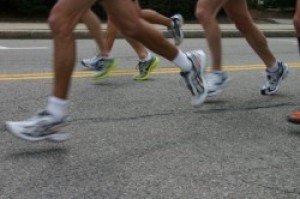 Running is a great cardiovascular exercise and has become a popular workout for both men and women alike. Finding the right pair of running shoes is essential for both the casual and the serious runner and there are some things to consider when purchasing a running shoe.
Running is a great cardiovascular exercise and has become a popular workout for both men and women alike. Finding the right pair of running shoes is essential for both the casual and the serious runner and there are some things to consider when purchasing a running shoe.
How far and often will you be running? If you are a casual runner (less than ten miles per week), then a good, basic running shoe will be fine. However, if you are training for a marathon, consider making a true investment in your running shoes for optimal performance. In both instances though, make sure you are buying a pair of shoes that match and support your foot the right way.
Consider the arch in your foot. Those with a high arch, need a running shoe with a curved shape. If you have an average arch, a semi-curved shoe might be the best fit. Those with a low arch or flat feet need a straight shape shoe.
Understand pronation, which is the rolling of the foot from heel to toe through the foot strike. A proper or neutral pronation is hitting the outside of the heel and up to ball of your foot evenly across the front. This is how your foot reduces the stress of impact. Underpronation means that the outside of your foot takes most of the shock instead of finishing in the neutral position. Overpronation is too much roll across from the outside to the inside of your foot.
To determine your level of pronation, look at the shoes you walk or run in. Most everyone will begin on the outside of the heel, the real indicator is the wear on the forefoot. If most of the shoe wear is:
• On the medial (inside) side then you Overpronate
• On the lateral (outside) side then you Underpronate
• Uniform across the forefoot then you have a Neutral Stride
Where will you be running? Most people run on pavement or sidewalks, so most running shoes are designed with this in mind. However, if you are going to be running on uneven or softer surfaces (such as mountain trails or grass), look at shoes intended for those kinds of surfaces.
Shop for running shoes late in the afternoon, as feet are at their peak size at this time of day. When trying on the shoe, make sure there is a full thumb width between the end of the longest toe and the end of the shoe and that the ball of your foot matches where it should be in the shoe. In a properly fit running shoe, the toe box will allow the toes to move freely. The heel should not slip or rub against the shoe and the sole should flex with ease where the foot flexes.
Find a store that specializes in running shoes. Typically, they will have a good knowledge of foot mechanics and will be able to help you make a decision on the best shoe for you.
If you run often, consider purchasing more than one pair of running shoes. This way, you can rotate them. And if you run often enough, your shoes should be replaced every six months or so.
Do consider price so your budget isn’t blown. As I stated earlier, if you are a casual runner there is no need to break the bank buying a pair of running shoes, but don’t sacrifice function, comfort and durability in the process.
Another thing to consider is orthotics. In some cases, no matter how well a shoe is made or functions, it is still not good for a persons foot. In these situations I recommend orthotics which will usually make up for the lost support in the shoe. We have found a specific brand that works very well for most people and is very inexpensive (about $20). They are not as customized as most orthotics but work almost as well.
Runners have a wide selection of styles, colors and levels of comfort from which to choose when looking at running shoes. Remember, whether you are a casual runner or a serious runner, comfort and excellent support are essential for the best performance!
As always, if you have questions about your running shoes, don’t hesitate to ask us. We may even be able to tell you if your current shoes are right for you.
Dr. Jason Schluter is a chiropractor at Schluter Chiropractic in Tulsa, OK.




